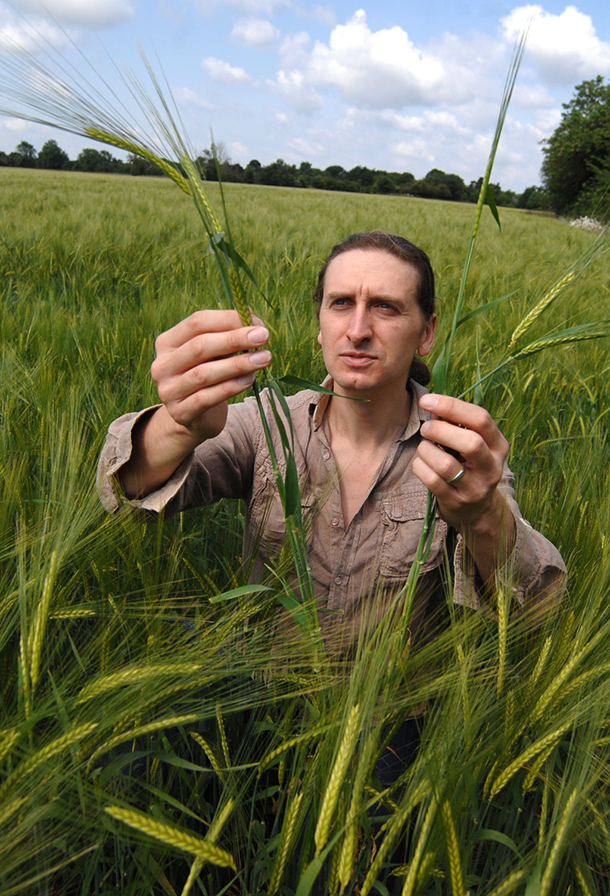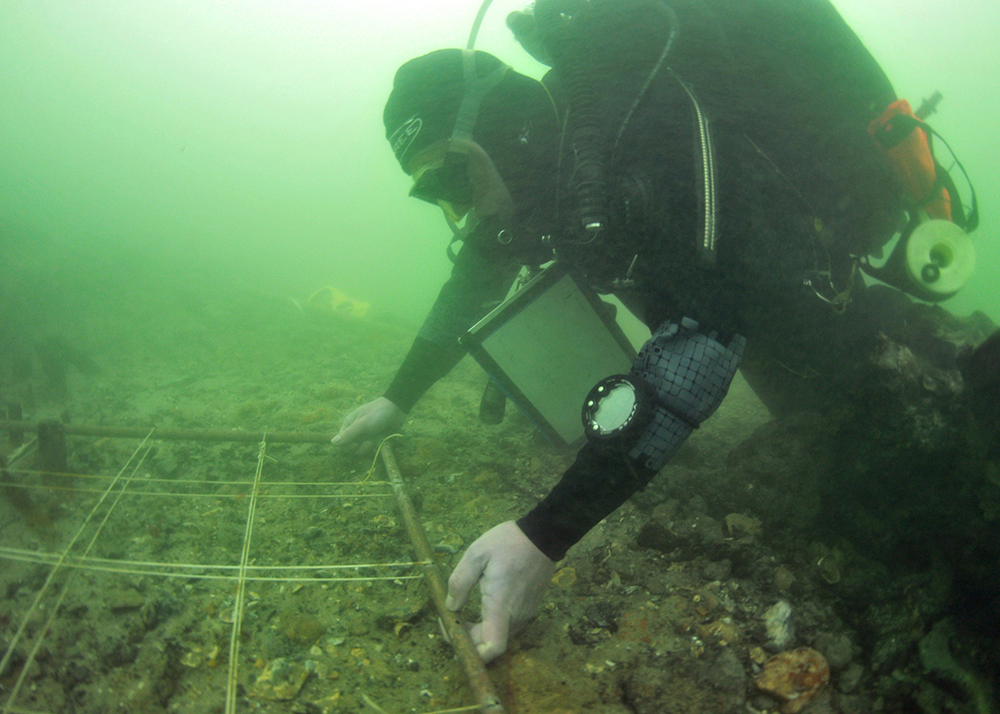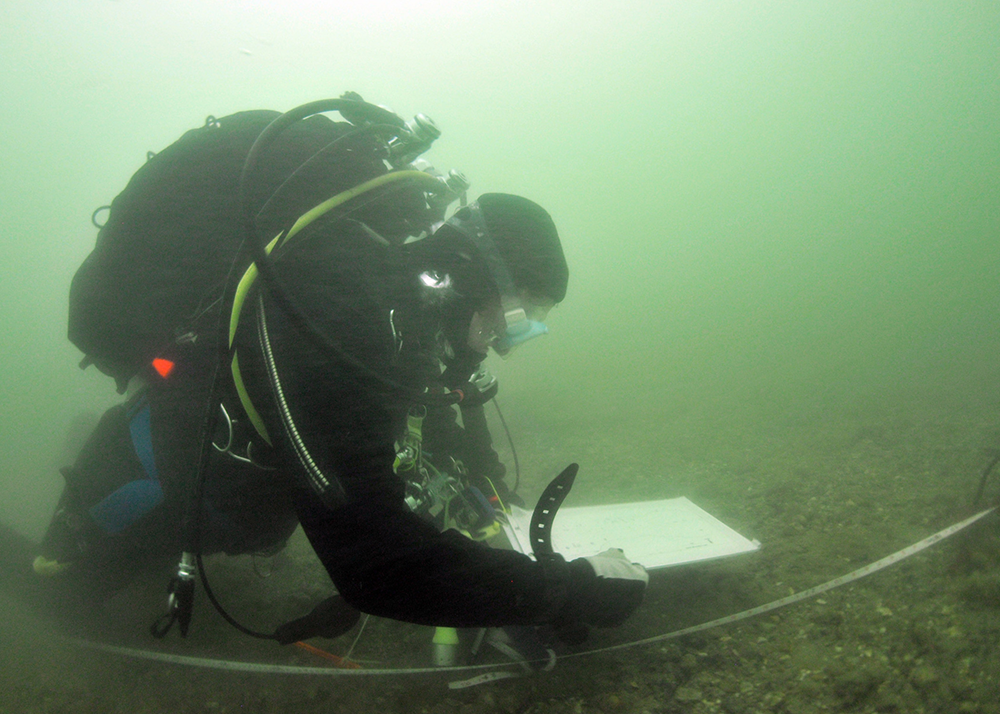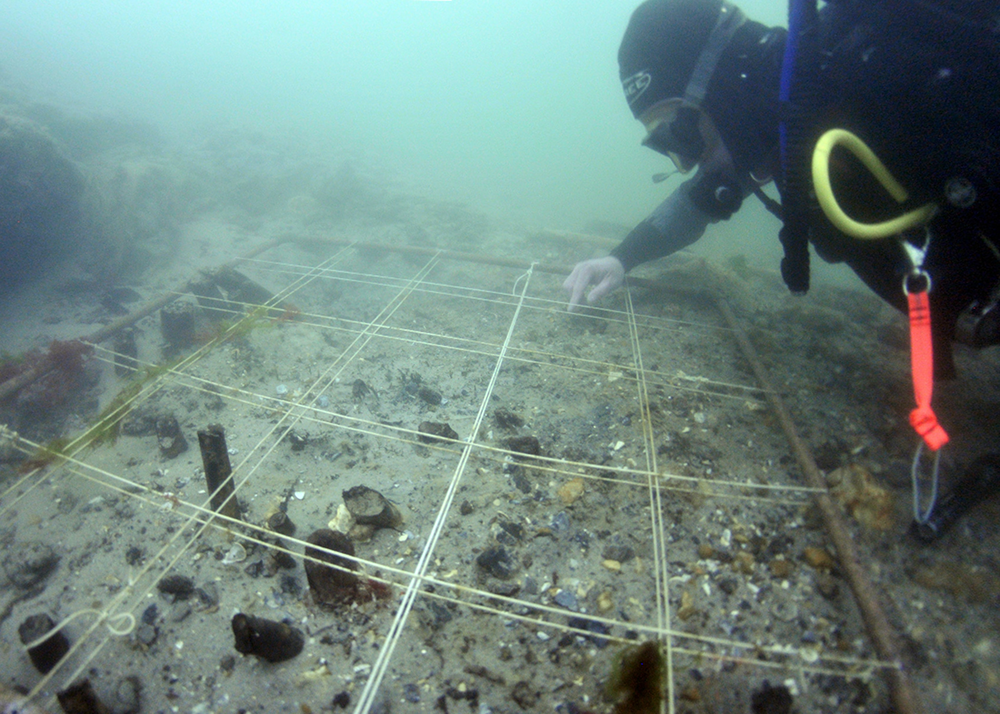Ancient Wheat and the Rise of Agriculture
Air Date: Week of February 27, 2015

Archaeologist Robin Allaby examines wheat. (Photo: courtesy of the University of Warwick)
The discovery of 8000-year-old wheat DNA off the coast of the UK has archaeologists rethinking their theories about the rise of agriculture in western Europe. University of Warwick professor Robin Allaby tells host Steve Curwood that Britain’s hunter-gatherers were not isolated as had been thought, but probably interacted and perhaps traded with European farmers.
Transcript
CURWOOD: It's Living on Earth. I'm Steve Curwood. The history of agriculture is pretty well established – it was first developed and adopted in the fertile crescent, the part of the middle east that curves from the Persian Gulf across modern Israel and Syria into Egypt. From there it gradually spread across Asia and Europe – reaching the far west and Britain about 6,000 years ago. But a recent discovery of ancient wheat DNA in ocean sediments off the British coast suggests that the grain arrived earlier, about 2,000 years before people began farming it there. Robin Allaby, who studies the evolution of plant domestication at the University of Warwick, was part of the team that made the discovery.
ALLABY: We examined 8,000-year-old soil, paleosoil we call it. That is about 11 meters under the sea off the coast of Britain and it represents the old land surface that existed during a time when sea levels were rising and what we found there was presence of wheat DNA amongst other things, which was incredibly surprising because that's about 2,000 years earlier than one would expect compared to the mainland UK. So, that tells us that Britain at that time was not the insular cut off island that it's conventionally reinterpreted as being, but, in fact, somehow was in contact with the early farmers that were present in Europe and at that time they would've been around about sort of south of France kind of area.
CURWOOD: Now, I understand you isolated this DNA from an underwater archaeological site. How and why did archaeologists zero in on that particular place?
.png)
Divers found traces of 8,000 year-old wheat DNA. (Photo: The Maritime Trust, Roland Brookes)
ALLABY: Well, that's a really good question. We were interested at this site, which is called Bouldnor Cliff, which is just off the coast of the isle of Wight in the Solent estuary. And what the archaeologists have found there is a boat building yard 5,000 years ago. So it's not a settlement where people lived at. They were building boats there. And the technology that they were using to build those boats was actually about 2,000 years ahead of its time, so they were splitting large timbers to produce their boats, and also they had flint technologies and shapes that will more akin to northern France than you see on the mainland UK. So the site itself seemed to be pointing towards Europe with these hints of early technology. So we were looking for a site in which to explore whether we could retrieve environmental DNA, so-called environmental DNA that's sort of free and living in sediments, and what we found is that submarine environments are actually incredibly good preservers of DNA. It's a constant four degrees down there, and the preservation was incredible. So it's like nature's fridge.
CURWOOD: How new is this technique of gathering and analyzing DNA from ocean sediments?
ALLABY: So this was a fairly new approach to looking at environmental DNA, so I think it's only the first or second application of marine sediment DNA analysis, but it's a real breakthrough. It's opened doors to a really exciting avenue of research, not least of which is that it releases latitudinal constraint on where one can do ancient DNA studies from quite considerable time depths because that four degrees, that nature's fridge, is constant all around the world. So we can go down into the tropics where it's notoriously difficult to have preservation of archaeological artifacts for biological DNA for more than a few thousand years, but you can go to the Red Sea for instance and go back tens of thousands of years.
.png)
Robin Allaby says that the cool temperatures of ocean make it great for preserving environmental DNA. (Photo: The Maritime Trust, Roland Brookes)
CURWOOD: So the ocean has more secrets than just its own flora and fauna down there. It keeps some of our secrets as well.
ALLABY: That's absolutely the case, yes. What's become clear from this study is that if you want to understand this process of neolithization, the change to farming in northern Europe, then probably the answers are under the sea, because these events were taking place on areas of land that were subsequently immersed in marine melt water from the glaciers.
CURWOOD: So, for folks who don't have atop of mind the archaeological history of the UK, what were people doing there some 8,000 years ago?
ALLABY: So 8,000 years ago people were living an existence that we describe as hunter gathering, which is how we define what we call the Mesolithic period. So they were hunting game, deer, Aurochs which are giant precursors of cows - grouse - they were gathering plant materials - things like hazelnut and berries and the like. And the difference between that and the emerging Neolithic peoples is that the Neolithic is defined by the growing of plants, so that arable agriculture, wheat and barley in particular.
CURWOOD: Now, how long will it be before people in Britain would start farming themselves?

Underwater archaeologists diving at Bouldnor Cliff off the coast of Britain (Photo: The Maritime Trust, Roland Brookes)
ALLABY: So, we don't see farming on British mainland until about 6,000 years ago, so that's some 2,000 years after the people we were examining at this site at Bouldnor Cliff.
CURWOOD: So this just raises all kinds of questions, this 2,000-year gap. First of all, why might it have taken so long for farming to catch on in Britain?
ALLABY: [LAUGHS] So that's the million-dollar question. The previous conventional thinking about why the Neolithic was late in the UK relative to Europe is that it was thought that Britain was cut off - it was an island. We've established that was not the case 8,000 years ago, and indeed, they were culturally connected. So we have the situation where we have a Mesolithic culture co-existing next to this Neolithic existence and that continues; they maintain their integrity for 2,000 years and the same kind of thing is actually being found in molecular anthropology as well at the moment, so the people that look at the human DNA from various skeletons, they're finding the same thing, that these two cultures are existing side-by-side. So the big question is why didn't the Mesolithic people switch over to a farming economy and there are basically two possibilities: either they didn't want to or they couldn't. And you can find arguments to both of those.
So the surprising thing about the arrival of farming is that it's associated with an absolute crash in health. So we have a lot of our diseases associated with the rise of farming as we come in close proximity to lots of animals, particularly. We're also very malnourished, so skeletons take a crash in size, and we get the development of bad teeth. So it's not hard to see that a person living with Mesolithic would rather stay with their higher calorific lifestyle. The alternative is that actually farming couldn't progress that far north simply because there was a limit to how well the component plants of the agricultural economy could adapt in that latitude as they moved further north. They would have liked to have grown wheat up there but they simply couldn't grow it. It just wasn't ready to be grown as far north as England. And I guess these are the questions to answer now.

Archaeologists diving at Bouldnor Cliff off the coast of Britain (Photo: The Maritime Trust, Roland Brookes)
CURWOOD: So it looks like this wheat that you found there in Britain came from some sort of contact with the south of France at about the same time, but as I understand it the scientific community has been split on whether migrating farmers from the east displaced the hunter gatherers in Britain rapidly or more gradually. What's your view now on the basis of this discovery? What kind of insight does it give you on the transition from hunting and gathering to farming in Europe and the UK?
ALLABY: So what this study shows is that unlike our previous assumptions the Mesolithic people had a contribution to the development of agriculture. They were using the products of the Neolithic technologies, products of farming, therefore, they were cognizant of farming and they knew how to apply its products, so to what extent were they instigators contributing to the rise of agriculture where previously we assumed that either the Neolithic people actually had physically replaced them genetically, so the Mesolithic peoples had died out, were replaced by farmers, or that very quickly the Mesolithic people just took off with the idea of farming. And we know, actually, we know both of those things are wrong. We know from genetic studies of human DNA that European people are actually a mix of Mesolithic and Neolithic, near east in origin DNA, and now we know the Mesolithic people were actually interacting with these Neolithic people, so there was a communication. So, somehow, together the development of farming and therefore, civilization after that occurred.
CURWOOD: One of the things that happens in this transition, you say, though, is there are crashes in the populations, it's not really healthy for humans to shift from hunting and gathering to what we would call modern agriculture. Why do you suppose that is?

Diving at Bouldnor Cliff off the coast of Britain, archaeologists found wheat DNA. (Photo: The Maritime Trust, Roland Brookes)
ALLABY: Probably because with switching from this highly proteinaceous diet to a high starch diet without actually being adapted to obtaining your nutrition and your energy from that particular source. So we know from the human genome that we are evolving to deal with the high starch diet. So, one can look at things like amylase genes, the genes that are responsible for breaking down starch. We have many copies of those genes so we produce more of that enzyme. When you compare it to either a chimpanzee or societies that have always been hunter-gatherers and they have much lower copies of those genes. So we are in a process of adapting to agriculture still, and one really should think of the interactions with humans and plants as a co-evolutionary process. So obviously when we first switched over to that economy it would've been a shock to our system. So we shouldn't be entirely surprised that it wasn't terribly good for us. The big mystery is why we did it, and that's another million-dollar question.
CURWOOD: OK. So let's ask that million-dollar question if it wasn't healthy for us why do we do it?
ALLABY: Well it does permit us to live high population densities. So the difference between a Mesolithic economy and this sedentary Neolithic economy is for one you need a large amount of space and the other one you don't. So it's quite easy or probably inevitable that those that take up this sedentary space - if you've only got a small amount of space - you have to go to an agricultural economy. And as that will naturally spread and that will spread encroaching into a sort of a Mesolithic sort of territory, so it may well have been the case that the Mesolithic peoples of Europe really did not want to switch to an agricultural economy, but at some point they would have had to switch as their own hunter-gatherer economy would have ceased to be viable as they lose more land to this encroaching advancement of arable agriculture.
CURWOOD: So at the end of the day maybe civilization is bad for us.
ALLABY: It could be the case, couldn't it? Clearly it paved the way for sort of this next step in our social evolution. I don't think anybody's going to argue that the rise of cities and civilizations in nation states was bad for us, but it has this sort of interesting contradictive or counterintuitive dynamic that we have to go through, a suboptimal existence. But the fact of the matter is, an agricultural economy worked and we might be less healthy but it can outcompete a hunter-gatherer economy albeit with sickly people than it's going to win out.
CURWOOD: So what comes next for you in terms of research and not only yourself but your team?
ALLABY: So where we would really like to look is the area known as Doggerland. This is the area which is under the North Sea now between Britain and Denmark and Germany which 8,000, 9,000 years ago was Dogger island and then Doggerland, so very fertile land which for the past 100 years or so fishermen have been pulling up the remains of mammoths and bones of giant elk and humans, so we know that there was human occupation of those sites. So those very early stages of the development of the Neolithic probably were occurring out in those regions so where we would really like to go is to look at our stuff to better understand how farming came to Europe and Britain.
CURWOOD: Robin Allaby is a Professor at the School of Life Sciences at the University of Warwick in the UK. Thanks for taking the time to speak with us today, Robin.
ALLABY: It was as an absolute pleasure. Thank you for having me.
Links
Study: Sedimentary DNA from a submerged site reveals wheat in the British Isles 8000 years ago
Archaeologist Robin Allaby is a professor at the University of Warwick
Living on Earth wants to hear from you!
Living on Earth
62 Calef Highway, Suite 212
Lee, NH 03861
Telephone: 617-287-4121
E-mail: comments@loe.org
Newsletter [Click here]
Donate to Living on Earth!
Living on Earth is an independent media program and relies entirely on contributions from listeners and institutions supporting public service. Please donate now to preserve an independent environmental voice.
NewsletterLiving on Earth offers a weekly delivery of the show's rundown to your mailbox. Sign up for our newsletter today!
 Sailors For The Sea: Be the change you want to sea.
Sailors For The Sea: Be the change you want to sea.
 The Grantham Foundation for the Protection of the Environment: Committed to protecting and improving the health of the global environment.
The Grantham Foundation for the Protection of the Environment: Committed to protecting and improving the health of the global environment.
 Contribute to Living on Earth and receive, as our gift to you, an archival print of one of Mark Seth Lender's extraordinary wildlife photographs. Follow the link to see Mark's current collection of photographs.
Contribute to Living on Earth and receive, as our gift to you, an archival print of one of Mark Seth Lender's extraordinary wildlife photographs. Follow the link to see Mark's current collection of photographs.
 Buy a signed copy of Mark Seth Lender's book Smeagull the Seagull & support Living on Earth
Buy a signed copy of Mark Seth Lender's book Smeagull the Seagull & support Living on Earth

